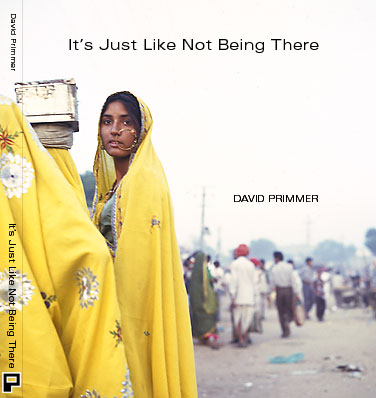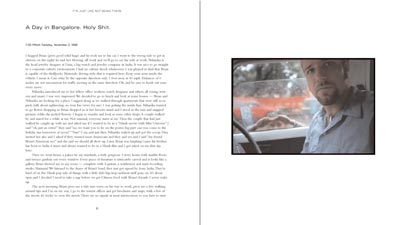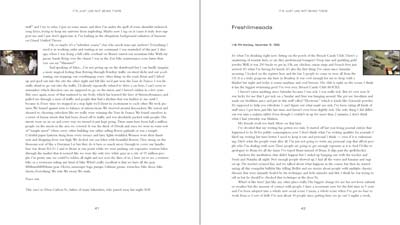Archives for my book category
Tuesday February 18, 2003
I handed a proposal to Chronicle Books today. Read below to find out about this amazing book!
Thank you Jen, Rose and Andie for helping me write it.
A cover letter, market analysis, and travel literature criticism, all thrown in together:
It’s Just Like Not Being There is a non-traditional, hybrid book that combines serial text and the author’s own photography. Originally published in email, it is similar to memoirs that make use of collected personal letters, although now these letters are from the digital age. The tone is precious and intimate, following a grand arc of discovery, which can be digested in small increments. The text holds an awareness of the audience reading it in the morning at work while sifting through their daily email. But the subject turns suddenly to one of the most important moments in any person’s life – the death of their mother.
It’s Just Like Not Being There is autobiographical and it is travel writing, but it is not purely a travel book. As a postmodern text, it plays with the bewildering surface of intersecting cultures, like Video Night in Kathmandu by Pico Iyer. There are no long descriptive passages exoticizing traditional romantic views of the East. There are no pictures of mud-caked sadhus swinging incense over the Ganges. Instead, it is closer in tone to works by Bruce Chatwin and Bill Bryson, both contemporary travel writers (and rich, white western men) who attempt to sidestep the colonialist nature of travel by detailing their own ironic bumbling.
Rather than trying to keep the distance between America and India intact by accentuating the exotic, It’s Just Like Not Being There celebrates the train wreck of global popular culture. It is postcolonial as defined by Simon During in Postcolonialism and Globalization because “it produces a mood in which exoticism, normality, and transworld sharedness combine, and in which consumption warmly glows.” It is simultaneous irony and humanism as best typified by Kurt Vonnegut. But it is not always easy and it is not always correct. In Tourists with Typewriters, Patrick Holland and Graham Guggan point out that “Travel writing is a genre that manufactures “otherness” even as it claims to demystify it.” And that postcolonial travel writers are conflicted by working in a genre “that is in many ways antithetical to them.” It’s Just Like Not Being There demonstrates that the Culture of India is not a thing that can be attacked or eroded by the west. It is built every day anew by every person living in that region with each decision they make.
The book includes color photography on most spreads, with 42 full-page photographs throughout. These photos are not only illustrative to the text, but allow the book to stand alone in the coffee table/fine art book genre. It is presented with a quiet and open design in an attempt to balance a voice that is loud and at times curmudgeonly. There are 35 small folios that bleed to the edge of the page to serve as visual markers for events in the text. As one reader noted, the folios, “serve as visual gossip,” equipping the reader with insight to the author’s point of view and personal details. Each photo was taken as the events in the story unfolded. Yet, the photos lack captions and are intended to stand alone from the text.
It’s Just Like Not Being There is simultaneously a memoir, a travelogue and a photographic journal. If this makes it difficult to place on a bookstore shelf, it also makes it stand out loudly. There are no other books like it.
Bibliography
Baudrillard, Jean. America: Verso 1986
Caulfield, Annie. Kingdom of the Film Stars. Lonely Planet 1997
Condon, Sean. Sean and David’s Long Drive. Lonely Planet 1996
During, Simon. “Postcolonialism and Globalization.” Meanjin 48, no. 2 1992 339-53
Eco, Umberto. Travels in Hyperreality. Harcourt Brace Jovanovich, 1986
Holland, Patrick and Huggan, Graham. Tourists With Typewriters: Critical Reflections on Contemporary Travel Writing. University of Michigan Press 2000
Iyer, Pico. Video Night in Kathmandu: And Other Reports from the Not-So-Far East. Vintage Departures 1988
McGrath, Melanie. Motel Nirvana: Dreaming of the New Age in the American Desert. Picador 1996
David Primmer’s Bio
Dave was born and raised in Renton, Washington, where he first experienced living in an alien culture. He studied writing at the University of Washington and was a rock journalist during the grunge era. When punk broke he went to San Francisco. He did artistic stuff like washing dishes and building playgrounds. Then it was 1992 and you could get rich in computers (yes! even then!). He started administrating large groups of computers and building email servers and web server clusters. He forgot about writing for a good 7 years and then decided to start writing email adventure stories to a hundred or so friends. Turned out, the computer work had served him well. Since 1999, tens of thousands of people have visited primco.org, the home of his writing and photography.
Saturday October 26, 2002
Thursday September 26, 2002
I laid out my book last night. Whew. I've exported a couple of sample spreads because I'm so proud of it.
Basically, I decided on Bembo. Bembo for the text and Univers Extended for the titles. That was the hardest part and the most crucial decision because the flow of the text varies a lot with subtle font changes and it would require re-positioning all the photographs. If the text moves even one page I have to re-import and place all 100 photos. That’s how Quark works.
It’s about 150 pages and there’s about 60 full size photos (a big gorgeous picture every 3 pages!) and about 40 little thumbnail folios. I decided that I wanted to put in some of the reference or documentary type photos that aren’t that interesting art-wise but help show the stuff I’m writing about. I like how they’re little visual navigation guides within the text. If you know what’s going on, you can find a section of the book by looking at the thumbnails.
Rose calls them "visual gossip" and I think that's a really cool thing to call them.
I was planning on scanning a bunch of the scraps of paper that I collected on my journey also. I have train tickets and matchbooks and stamped documents of all kinds. I thought those would be neat as folios also. Right now I just have photo thumbnails but I may work on scanning those little buggers.
I haven't decided about using a border around the photos. This is the way they are on the website but I'd initially planned to go borderless for the book. But looking at it laid out with borders for so long is changing my mind. If anyone has a suggestion about this or any thing else book related I'd appreciate it.
I'm also not sure about the font for the timestamp. It's Russell Square and I think it might be a little too techy. The process of writing this stuff and putting it out so people can read it has been immensely technical. Webservers, laptops, stylesheets, browsers, XML, spellcheckers, autocorrecters, the Indian Telecommunications Infrastructure, digital scanning, unsharp masking, DV taping, pirating $20,000 worth of fonts off the Internet. It's all been a huge learning experience. Except for running the printing press and doing the chemical processing of my film, I've done everything. And that font is a tiny homage but maybe it doesn't work. Don't know.
The main work of design is done. Now I need to collect all the scanned images,
resize and otherwise get them ready for printing (no small feat) and find a
damn printer. I’m worried that all the little thumbs will double the cost
of my book. That may be a struggle to justify and I may have to toss them. Anyhow,
I’m hoping for <10 dollars a book printing costs. I know, stupid.
Friday September 13, 2002
I have it pared down to roughly 60 photographs and about 55,000 words. It is hard to cram that into a small, inexpensive book and still make it look like a nice beautiful art book. No matter how much you fiddle with fonts and margins and gutters it still wants to be a 300 page monster. I'm going to try to keep from getting hellishly drunk every night so I have some time left over to design this book. Making a book like this is really hard because I have to place all the photographs and they have to be at the right place in the text and it all has to flow properly even after I nudge a margin in. Plus, I want to put a lot of beautiful little individual flourishes in it like McSweeney's does.
I'm taking the first few entries from "November", when I first arrive in India, and dropping all the later stuff about Thailand and even the first part of the "IJLNBT" and making it all flow together. So I skip from my first day in India and can't figure out how to turn on a faucet, ahead to the next year when I'm getting dragged through the back door of the Taj Hotel into the Bombay Times Party. I'm leaving in all the Mom and Mystery Woman stuff. It's going to be gorgeous and unlike anything in any bookstore.
Tuesday September 10, 2002
I'm working on my book. At this point, it's going to be 8x8 hardcover and half photographs. Not sure how many pages I can do but I'm hoping 250. Ok, that's my stupid dream. I'm looking at on-demand printers right now and selecting the images. I have been thinking that I have to trim down "November" and "It's Just Like Not Being There" and I hate to do it because I have this thing about not editing afterwards but I want to put a lot of photos in the book and the text alone is almost 300 pages at this point. I'm also trying to learn QuarkXpress because I'm going to design it myself. That's basically why I don't give a shit about this blog anymore.
voyeurs of the world, give something back!
| Sun | Mon | Tue | Wed | Thu | Fri | Sat |
|---|---|---|---|---|---|---|
| 1 | 2 | 3 | ||||
| 4 | 5 | 6 | 7 | 8 | 9 | 10 |
| 11 | 12 | 13 | 14 | 15 | 16 | 17 |
| 18 | 19 | 20 | 21 | 22 | 23 | 24 |
| 25 | 26 | 27 | 28 |
Search
Archives
- May 2006
- October 2005
- September 2005
- May 2005
- April 2005
- March 2005
- February 2005
- November 2003
- October 2003
- September 2003
- August 2003
- July 2003
- June 2003
- May 2003
- April 2003
- March 2003
- February 2003
- January 2003
- December 2002
- November 2002
- October 2002
- September 2002
- August 2002
- July 2002
- June 2002
- May 2002
- April 2002
- March 2002
- February 2002
- January 2002
- December 2001
- November 2001
- October 2001
- September 2001
- August 2001
- July 2001
- June 2001
- May 2001



